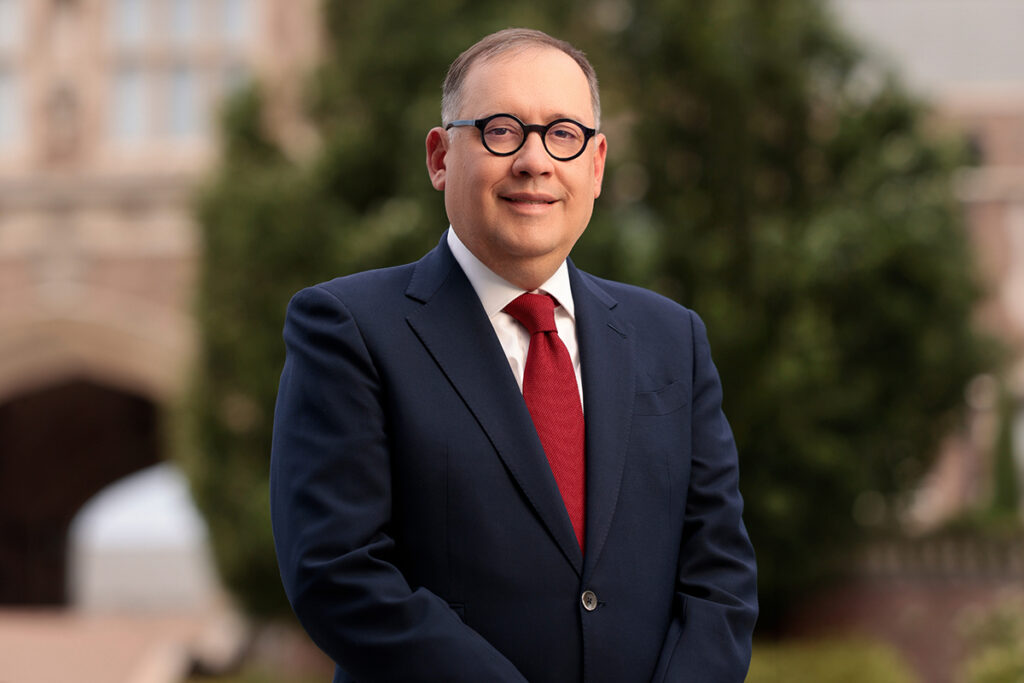This year, St. Louis celebrates the 150th anniversary of the Eads Bridge, which was an incredible feat of engineering when it opened in 1874. At my inauguration as chancellor of Washington University in St. Louis five years ago, I drew on the Eads Bridge as an example of what St. Louis and WashU can achieve when we unite in common cause.
WashU’s second chancellor, William Chauvenet, mathematically confirmed the calculations James Buchanan Eads used to design the bridge. Chauvenet also invented a revolving mirror to measure the elastic limit of steel and iron, a combination of materials that allowed Eads to build a bridge that would withstand the strength and width of the Mississippi River.
The Eads Bridge, which became a great symbol of St. Louis, is now the oldest bridge still standing along the Mississippi.
Whenever I see this bridge, I am reminded that WashU and St. Louis share a powerful potential for progress when the people of this region work together. From the start of my tenure as chancellor, I have been dedicated to ensuring that WashU is “in St. Louis, for St. Louis” – that we draw upon our strength as an economic anchor; our role as a global talent magnet; and the power of our mission of research, education, and patient care to create real, lasting impact and opportunity in St. Louis and beyond.

As an educational institution and the region’s second-largest employer, WashU has not only a significant presence in St. Louis but also a significant responsibility to our stakeholders, whether they are students, alumni, employees, or neighbors. This responsibility is embedded in WashU’s history. The university originally formed in response to a regional need to educate the area’s workers so they could find better paying jobs. We have recommitted ourselves to that bedrock goal through WashU’s reimagined School of Continuing and Professional Studies (CAPS). The new school has strategically designed its course offerings to meet the needs of St. Louis residents and the demands of local industry, drawing on such sources as Greater St. Louis’ 2030 Jobs Plan for guidance.
It also works to make a WashU education more accessible to nontraditional learners, and to people who have historically been excluded from higher education. For example, CAPS recently launched a new 26-week program called “Empower: Career Success for Refugees” to provide these newest St. Louisans with the advanced language and professional skills they will need to thrive in high-opportunity industries like health care.
As one of St. Louis’ largest anchor institutions, WashU has also dedicated itself to the work of diversifying its suppliers and contractors to support local small business owners who have historically been impacted by racial and economic inequities. The university welcomed five new restaurants to campus this year, each one an outlet for a local minority- or woman-owned business, which redirected $7 million to these businesses. WashU collaborates with other large organizations and companies in this region through the St. Louis Anchor Action Network, with an eye on increasing employment, income and wealth among communities that have long faced systemic racial inequity.
Even as WashU works to support local businesses, we want to attract new, innovative commerce to St. Louis by employing our status as a world-class research institution to accelerate inclusive economic growth in our region. This year, we opened the Jeffrey T. Fort Neuroscience Research Building that aims to set the standard for the future of medical research. We also announced a new partnership with Deerfield Management to form VeritaScience, a private R&D company, that will generate more than $130 million in investment into the regional economy. Our goal is to create an atmosphere that attracts the world’s best minds to St. Louis, and to help create a city that inspires them to stay.
WashU’s role in the Eads Bridge, and in St. Louis history, bears witness to the idea that partnership is a path to prosperity. WashU is laying the groundwork to rise to this challenge, knowing that we have not always succeeded, but realizing that we must boldly embrace the opportunity to excel in these efforts, just as we do in our teaching, research, and patient care. The next great St. Louis breakthrough may not rely on engineering or mathematical prowess, but it will require us to collaborate deeply and creatively with the same uncompromising commitment that James B. Eads and William Chauvenet brought to their signature work.
I believe that when anchor institutions like ours commit to leverage our strengths and coordinate our efforts, we can bridge the gap between our current realities and the overarching goals of economic equity, vitality and vibrancy that we all share for this great city we call home.
(This article was originally published July 11, 2024, in the St. Louis Business Journal.)